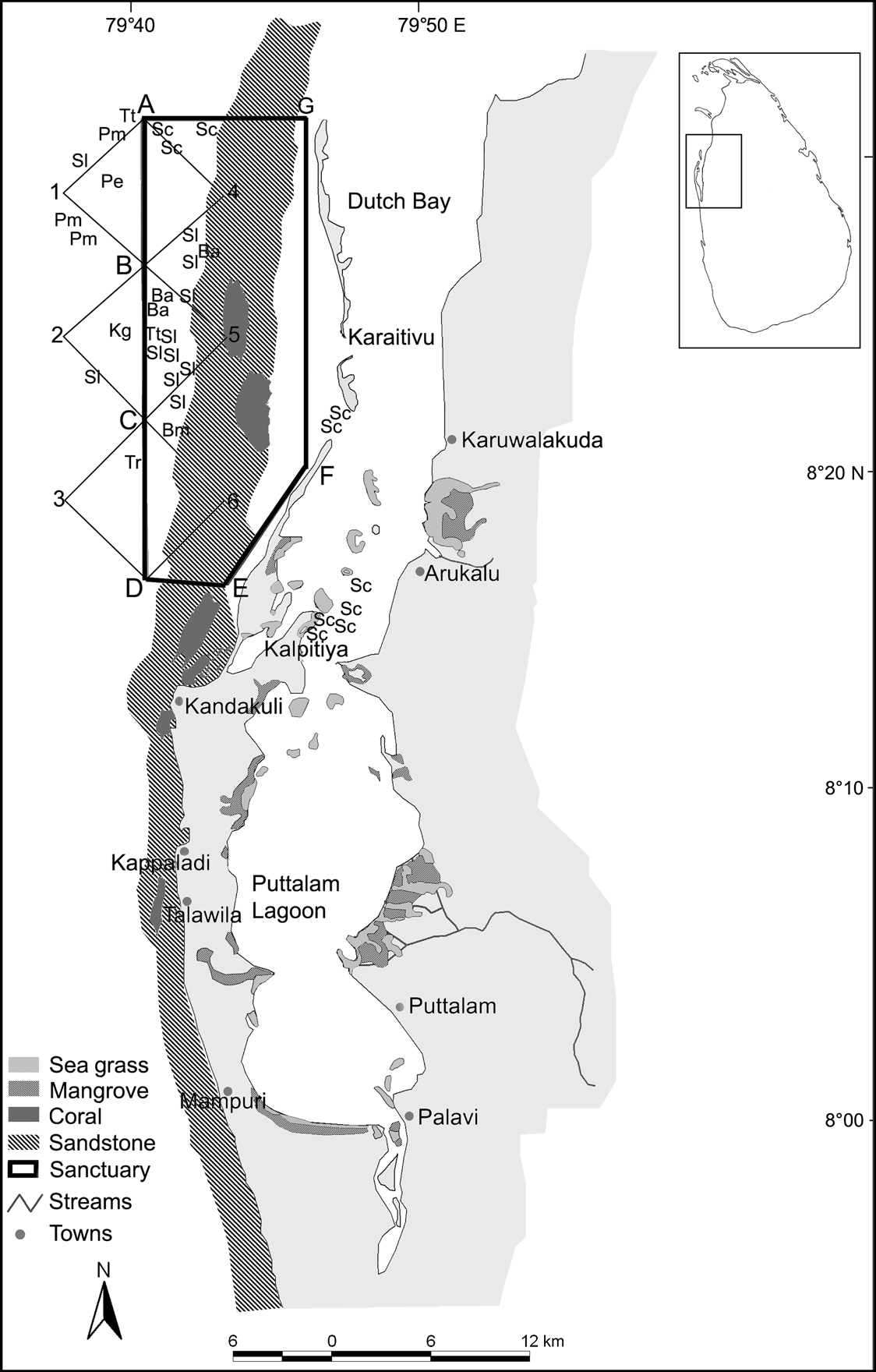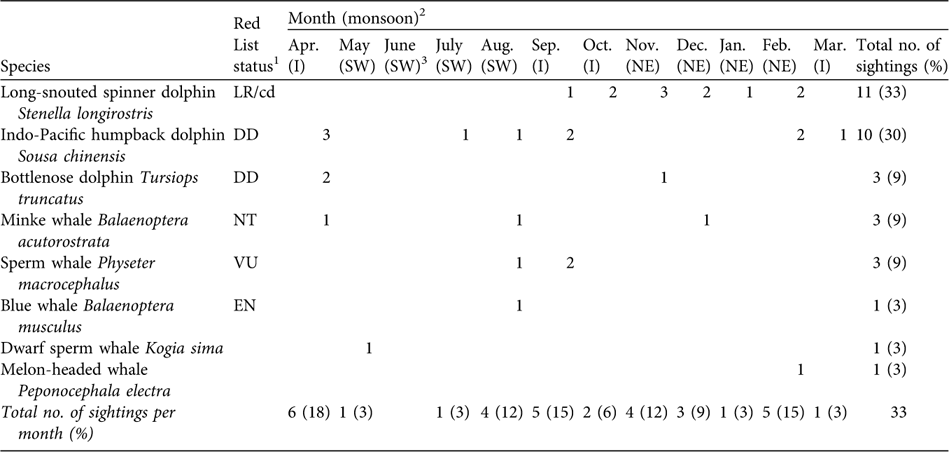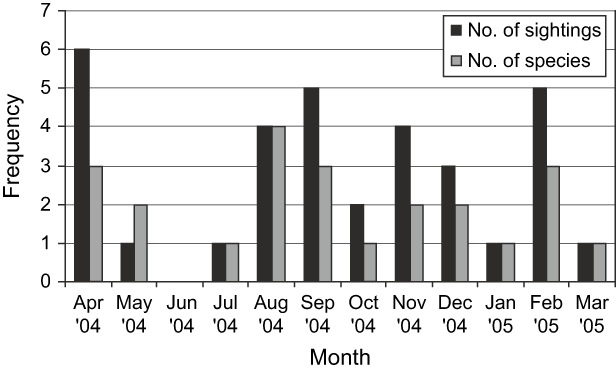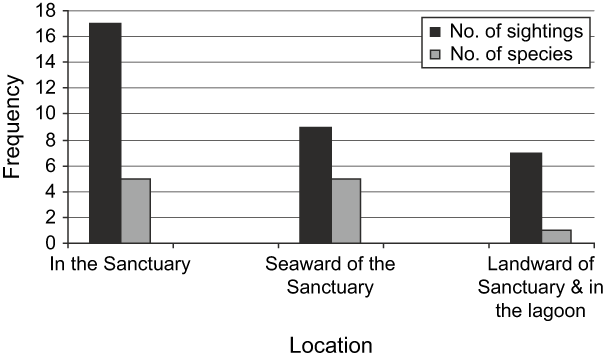Introduction
Various studies of cetaceans have been conducted in South Asia (Alling, Reference Alling1986; Sathasivam, Reference Sathasivam2000; Kumaran, Reference Kumaran2002;), including off the southern and eastern coasts of Sri Lanka (Leatherwood et al., Reference Leatherwood, Peters, Santerre and Clarke1984; Ilangakoon et al., Reference Ilangakoon, Ratnasooriya and Miththapala2000), where a total of 27 species has been recorded (Ilangakoon, Reference Ilangakoon2002). However, little is known regarding cetaceans in other areas of Sri Lanka. Off the west coast Stenella longirostris (Ilangakoon, Reference Ilangakoon2002), Tursiops truncatus (Leatherwood et al., Reference Leatherwood, Peters, Santerre and Clarke1984) and Balaenoptera acutorostrata (Ilangakoon, Reference Ilangakoon2002) have been recorded in the vicinity of the Bar Reef Marine Sanctuary (Fig. 1). Two museum specimens from strandings, collected in 1891 and 1934 (Ilangakoon, Reference Ilangakoon2002), and a possible unconfirmed sighting in the early 1980s around Dutch Bay (Leatherwood et al., Reference Leatherwood, Peters, Santerre and Clarke1984), indicated the presence of Sousa chinensis off the west coast. Megaptera novaeangliae (Leatherwood & Reeves, Reference Leatherwood and Reeves1989) and Physeter macrocephalus (Alling et al., Reference Alling, Gordon, Rotton and Whitehead1982; Ilangakoon, Reference Ilangakoon2002) have been recorded further offshore.

Fig. 1 The survey area, showing the Bar Reef Marine Sanctuary, survey transects and cetacean sightings. Rectangle on inset indicates the location of the main figure in Sri Lanka. Ba, minke whale Balaenoptera acutorostrata; Pm, sperm whale Physeter macrocephalus; Pe, melon-headed whale Peponocephala electra; Sc, Indo-Pacific humpback dolphin Sousa chinensis; Bm, blue whale Balaenoptera musculus; Ks, dwarf sperm whale Kogia sima; Tt, bottlenose dolphin Tursiops truncatus; Sl, long-snouted spinner dolphin Stenella longirostris.
The 307 km2 Bar Reef Marine Sanctuary, located off the Kalpitiya peninsula in north-west Sri Lanka, was declared in 1992 to protect the largest coral reef area in the country. Because of restricted access to these coastal waters the region has been relatively well protected from unsustainable fishing practices. However, an increase in unsustainable fishing methods, including the illegal use of dynamite, has been observed more recently both in the Sanctuary and outside (Dayaratne et al., Reference Dayaratne, Linden and de Silva1997). One of the threats to marine life in the area is the bycatch of small cetaceans and sea turtles (Dayaratne & Joseph, Reference Dayaratne and Joseph1993; Leatherwood & Reeves, Reference Leatherwood and Reeves1989; Kapurusinghe & Cooray, Reference Kapurusinghe and Cooray2002).
The aim of this study was to examine the spatial and temporal distribution of cetaceans in and around the Bar Reef Marine Sanctuary, and also to determine species richness, seasonal distribution and to identify possible hotspots of cetacean occurrence. The results were used to develop recommendations and guidelines for management, and will facilitate further cetacean studies and marine mammal conservation initiatives in the area.
Methods
Two 1-day cetacean sighting surveys, using standard line transect methodology, were carried out monthly for 12 consecutive months from April 2004 to March 2005. Each month one survey was within the Sanctuary (Fig. 1, A-4-B-5-C-6-D) using a small outboard-powered boat, and one west and seaward of the Sanctuary boundary (Fig. 1, A-1-B-2-C-3-D) from a 3.5 t motorized fishing boat.
Each survey had two or more observers. When three observers were present they rotated through the positions of port, bow and starboard observer at 30 minute intervals to avoid fatigue. Port and starboard observers searched from the beam of the vessel to approximately 10° past the bow while the bow observer searched directly ahead of the vessel in a 20° cone in front and also acted as the data recorder. When only two observers were present they searched on the port and starboard sides and also took turns at recording data, and observer positions were rotated at 1 hour intervals. In each survey the same pre-planned transect line (of c. 60 km), designed to maximize coverage of the area, was followed using a hand-held global positioning system. Surveys were carried out only during appropriate weather, when visibility and sea-state were deemed to be within suitable limits. Cetaceans encountered were approached, to identify species and estimate group sizes. Data recorded included time of sighting, position, bearing course, sighting angle, estimated distance, species and group size. Where possible close range photographs were taken.
Results
Because of rough sea conditions caused by the south-west monsoon (May-August) the June 2004 survey beyond the Sanctuary boundary had to be abandoned. The Sanctuary survey, using the small boat, was carried out only in 9 of the 12 months because the weather was too rough in May, June and July. In total we are able to carry out surveys on 21 days. A total of 33 separate sightings were made of eight cetacean species, of which four are on the IUCN Red List and two are categorized as Data Deficient (IUCN, 2007; Table 1). The most common species encountered was S. longirostris (33% of all sightings). This species was also seen in large schools during the inter-monsoonal months, with some groups containing >1,000 animals, including numerous juveniles. The second most common species was S. chinensis (30% of sightings). The other six species each comprised <10% of total sightings.
Table 1 The nine species of cetaceans seen in the Bar Reef Marine Sanctuary area, ordered by total number of sightings, with Red List status (IUCN, 2007) if any, and monthly sightings from April 2004 to March 2005.

1 EN, Endangered; VU, Vulnerable; NT, Near Threatened; LR/cd, Lower Risk: conservation dependent; DD, Data Deficient
2 I, inter-monsoon; NE, north-east monsoon; SW, south-west monsoon
3 No surveys due to unsuitable weather and sea conditions of the south-west monsoon
Cetaceans were seen in all months of the year except June, when there were no surveys either within or outside the Sanctuary because of the prevailing south-west monsoon. The largest number of sightings was during the inter-monsoonal month of April when sighting conditions were generally good. Species richness of sightings was highest in the south-west monsoonal month of August when four species were seen (Fig. 2). The most commonly observed species, S. longirostris, was observed during 6 consecutive months (September–February) during the north-east monsoon, and was not observed during the south-west monsoon. All three species of large whales (Balaenoptera musculus, B. acutorostrata and P. macrocephalus) were observed during the south-west monsoon, in August.

Fig. 2 Cetacean sightings and species richness by month in the Bar Reef Marine Sanctuary from April 2004 to March 2005.
Approximately 50% of cetacean sightings were recorded within the Sanctuary despite there being more surveys outside the Sanctuary. There was no difference in species richness between the Sanctuary and the offshore survey, with five species being observed in each area (Fig. 3). Most cetacean sightings were in the northern and central parts of the Sanctuary and concentrated around the western, seaward boundary where there is a change in water depth, whereas there were no sightings in the southern section of the Sanctuary (Fig. 1). S. longirostris and T. truncatus were recorded throughout the central part of the Sanctuary and were also seen in deeper offshore waters seaward of the Sanctuary boundary. We also observed S. chinensis in the northern part of the Puttalam lagoon between Kalpitiya and Uchchimunai, in the shallows close to the shoreline; in the Sanctuary there were seen only three sightings, in the north-west (Fig. 1).

Fig. 3 Cetacean occurrence in the three sighting areas in and around the Bar Reef Marine Sanctuary from April 2004 to March 2005.
B. acutorostrata was seen only within the Sanctuary whereas P. macrocephalus sightings were limited to deeper offshore areas. The single B. musculus sighting was within the Sanctuary where water depths are shallow to moderate, and not in the deeper waters beyond the Sanctuary as would be expected. Both Kogia sima and Peponocephala electra were encountered in deeper offshore waters beyond the Santuary, which is in accordance with their normal oceanic distribution.
Several threats to cetaceans were identified. Some of these threats are species-specific whereas others are general threats that affect all species: (1) Illegal use of destructive fishing techniques such as dynamite and Leila nets (a form of bottom purse-seine where divers drive fish into the net), sometimes in combination, in marine areas within and adjacent to the Sanctuary; large numbers of Leila boats were seen operating within the Sanctuary, especially in the northern part, throughout the study. (2) Large numbers of boats, both fishing boats and navy vessels, moving at high speed within the Puttalam lagoon; in one instance three boats were seen speeding through a small pod of S. chinensis, c. 2 km north of the Kalpitiya harbour. (3) Nylon gillnets are used extensively for fishing in the deeper offshore waters; this is a threat to all small cetaceans as they are prone to accidental bycatch in such nets. (4) Increased shipping traffic is a potential threat with the commencement of the dredging of a shipping channel between India and Sri Lanka under the Sethusamudram Project through the Gulf of Mannar and Palk Strait.
Discussion
The eight species of cetaceans observed in and around the Bar Reef Marine Sanctuary account for 30% of species recorded in Sri Lanka's waters (Ilangakoon, Reference Ilangakoon2002). During the total of 21 survey days three species of large whales (B. musculus, B. acutorostrata and P. macrocephalus) were seen. Although appearing in fisheries bycatch, sightings of S. chinensis and P. electra had not previously been confirmed in Sri Lanka's waters, and K. sima had only been seen off the east coast and found in fisheries bycatch off the west coast (De Silva, Reference De Silva1987; Leatherwood & Reeves, Reference Leatherwood and Reeves1989; Ilangakoon, Reference Ilangakoon1997; Ilangakoon et al., Reference Ilangakoon, Ratnasooriya and Miththapala2000). S. chinensis was observed both in the shallow coastal waters of the Sanctuary and in the northern portions of the Puttalam lagoon. We were also able to confirm earlier indications (Ilangakoon, Reference Ilangakoon2002) that B. acutorostrata are found frequently in this area and that the waters of the Sanctuary are a year-round habitat for this species, with sightings in all seasons. In summary, our sightings indicate that the Bar Reef Marine Sanctuary and its surrounding waters are an important habitat for cetaceans.
Although our survey was only conducted over 1 year and four of the 24 planned surveys had to be cancelled, certain conclusions can be made about the temporal distribution of cetaceans in and around the Sanctuary. Cetaceans are present in these waters throughout the year and were even seen during the south-west monsoon in May–July. S. longirostris was seasonal in its occurrence, only being observed from September to February. In most sightings of this species it was in association with species of tuna, especially yellow-fin tuna Thunnus albacares. Although S. longirostris has been documented in tuna-dolphin associations in the eastern tropical Pacific (Perrin & Gilpatrick, Reference Perrin, Gilpatrick, Ridgway and Harrison1994), this association has not been extensively documented in the northern Indian Ocean (Ilangakoon, Reference Ilangakoon2002). In two of the 11 sightings of S. longirostris large groups of 500-1,000 individuals were observed, and these sightings coincided with the yellow-fin fishing season.
B. musculus and P. macrocephalus were seen in the area only during the inter-monsoonal period of August-September after the south-western monsoon had subsided. Additional surveys are required to obtain more insight into the migration and feeding patterns of these species in Sri Lankan waters as there were indications that both species were feeding. Sightings of B. acutorostrata in April, August and December indicated that the species is present in this area during most of the year. The species has not been recorded as occurring frequently in other parts of Sri Lanka's waters but based on earlier sporadic sightings in this area and several strandings further north, it had previously been suspected that the species is more common in north-western waters (Ilangakoon, Reference Ilangakoon2002).
All sightings of S. chinensis seemed to coincide with inter-monsoonal periods (August-October and February-April) when the sea was calm. However, as this species is somewhat subdued in its surface behaviour, the likelihood of sightings was also higher during calm periods. S. chinensis has been studied extensively in Hong Kong, where they seem to feed mainly on a variety of fishes and, although they may sometimes ingest cephalopods and crustaceans, these do not make up a major portion of their diet (Jefferson, Reference Jefferson2000). Our sightings of this species in the lagoon coincided with prawn fishing.
Although a higher number of surveys were conducted seaward of the Sanctuary there were more cetacean sightings within the Sanctuary, indicating that it is not only an important area for corals and associated organisms but also for cetaceans. S. chinensis was observed in the northern part and the lagoon mouth on a regular basis, and is limited to shallow areas. The three observations of P. macrocephalus in the deeper waters are as expected; the species is common in Sri Lankan waters and has often been seen in the deeper coastal waters off the island (Alling et al., Reference Alling, Gordon, Rotton and Whitehead1982; Leatherwood et al., Reference Leatherwood, Peters, Santerre and Clarke1984; Ilangakoon, Reference Ilangakoon2002). Although the Southern Ocean population of B. acutorostrata is reported to be pelagic with a circumpolar distribution (Ilangakoon, Reference Ilangakoon2002), our results indicate a preference for coastal and near-shore waters and the Sanctuary therefore seems to be an important habitat for the species.
Although we observed the use of dynamite in conjunction with bottom purse-seine nets S. chinensis did not seem to be disturbed by the use of dynamite at relatively close distance, indicating that the species may be accustomed to the frequent occurrence of these activities in this area. The small range of habitat in which S. chinensis was observed may indicate a threat to this species as these shallow areas are used extensively by high-powered fishing and navy vessels. Several observations were made of one large adult with a deep scar on the upper surface of its back between the dorsal fin and peduncle, probably caused by a propeller cut or rope burn. Other potential threats to this species are habitat degradation and depletion of food sources as the lagoon is currently being overfished (Dayaratne et al., Reference Dayaratne, Linden and de Silva1997).
Studies in other parts of Sri Lanka have shown that S. longirostris is the most frequently caught species in gillnet bycatch, with large numbers being killed each year (Leatherwood & Reeves, Reference Leatherwood and Reeves1989; Dayaratne & Joseph, 1998; Ilangakoon et al., Reference Ilangakoon, Ratnasooriya and Miththapala2000; Ilangakoon, Reference Ilangakoon2002). We saw large schools of this species, with many juveniles, in areas where gillnet fishing was occurring.
Although shipping traffic has been found to be a common threat to cetaceans in most areas off Sri Lanka, with some accidental strikes on large whales being reported (Ilangakoon, Reference Ilangakoon and Bambaradeniya2006), the north-western waters have been comparatively free of large vessel traffic. This will change with the completion of the Sethusamudram shipping channel project, which started in 2005 and is presently ongoing with scheduled commencement of operation in 2009.
All marine mammals are legally protected in Sri Lanka under both the Fauna and Flora Protection Ordinance as amended in 1993 and the Fisheries Act of 1996. However, implementation of these laws is weak and fraught with difficulties. One of the major reasons identified as a cause for non-implementation is a shortage of trained personnel and equipment among law enforcement authorities (Ilangakoon, Reference Ilangakoon and Bambaradeniya2006).
Based on the results of this year-round survey we make several recommendations for the conservation and management of marine mammals in the Bar Reef and Puttalam lagoon area: (1) S. chinensis should be recognized as having the potential to be an important non-consumptive resource for ecotourism and a flagship species for marine environmental conservation, if it could be protected and properly managed. Its year-round presence in the direct vicinity of appreciative coastal communities makes it a suitable species for this purpose. (2) The fact that most cetacean sightings were made in the northern and central parts of the Sanctuary should be reflected in any future management plans; at present insufficient attention is given to the conservation of cetaceans in this area. (3) Enforcement of laws under the Fauna and Flora Protection Ordinance and Fisheries Act should be considered as a priority by the Department of Wildlife Conservation and Ministry of Fisheries and Aquatic Resources, especially within the Sanctuary where there is a need to halt destructive and illegal practices such as the use of dynamite and Leila nets. (4) Capacity building among law enforcement authorities and local staff of both government bodies in relation to marine protected areas in general should be undertaken as an ongoing activity. (5) Additional research is required to document further the presence of cetaceans in and around the Sanctuary.
The report based on this research was submitted to all relevant government authorities in Sri Lanka, including the Ministry of Fisheries and Aquatic Resources and Department of Wildlife Conservation. However, no follow-up research has yet been carried out in the area since the completion of this study because of a re-escalation of the prevailing ethnic conflict in Sri Lanka, which affects this area and makes it unsafe for researchers.
Acknowledgements
This study was conducted under the Coastal Resources Management Project, implemented by the Ministry of Fisheries and Aquatic Resources with technical assistance provided by ARCADIS Euroconsult, IUCN-Sri Lanka and ECL. Funding for this project was provided by the Asian Development Bank and the Royal Netherlands Embassy. Special thanks to Indira Fernando, Mohammed Nuzry and Palitha Muthukude for logistical support and to Ramani Jayewardene for being a great observer.
Biographical sketches
Koen Bröker is a marine ecologist working in biodiversity conservation and international environmental project management. He was the Co-team Leader for the Coastal Resources Management Project in Sri Lanka, which initiated and funded this project. Anouk Ilangakoon is a member of the IUCN Cetacean Specialist Group and has been involved in cetacean research in the Asian region since 1985. She is the author of the guide Whales and Dolphins of Sri Lanka.








